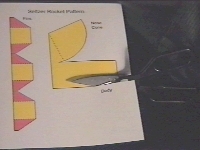1. Cut the fins out. Cut the nose cone and body out as one piece.
2. Tape the body onto the film canister, roll the paper around the side, and tape the end down. The lid end of the film canister goes down.



by Mike Passerotti
To design a paper rocket propelled by Alka-SeltzerŪ and water to demonstrate Newton's third law of motion.
For other interesting experiments with Alka-SeltzerŪ see Student Experiments.
The paper rocket in this activity is propelled according to the principle stated in Isaac Newton's third law of motion: "For every action there is an opposite and equal reaction." Gas pressure builds inside the film canister due to the mixing of Alka-SeltzerŪ and water. This action continues until enough pressure builds to blow apart the canister from its lid. The reaction is the launch of the rocket.
card stock printed pattern; empty film canister with lid that snaps inside; markers, crayons, or colored pencils; tape; glue; scissors; Alka-SeltzerŪ tablets; water; metric tape measure or meter sticks; straw; (Optional launch pad: wood block, coat hanger or other stiff wire)
Review and prepare materials. It is most important to use film canisters with lids that snap inside. Do not use lids that close around the outside of the canister.
|
1. Cut the fins out. Cut the nose cone and body out as one piece. |
2. Tape the body onto the film canister, roll the paper around the side, and tape the end down. The lid end of the film canister goes down. |
|
|
|
|
3. Roll the nose cone around in the shape of a cone and tape it together. Straighten the nose cone point to the center of the rocket and tape it to the sides. |
4. Fold the fins so that the colored side is out. Tape or glue the fin halves together to form a complete circle. |
|
|
|
|
5. Slide the fins over the body and tape in place. |
6. Cut a 1 inch piece of straw and tape it to the body. |
|
|
|
This is an outdoor activity. If gusty winds are a problem, then place a quarter in the canister to keep the rocket from falling over. Launching near a wall where a metric tape has been hung or where meter sticks have been stacked may make it easier to judge how high the rocket goes. You may want to wear safety glasses during this experiment as a general safety precaution. Everyone should stand away from loaded rockets when they are on the launch pad. It may take 15 to 20 seconds to build up enought pressure to launch, so a loaded rocket should not be approached prematurely. These rockets can shoot 5 meters or more into the air. No sharp objects should be placed on top of the nose cone or elsewhere on the rocket.
Make a launch pad with a block of wood and a straight piece of wire. Drill a hole for the wire and insert the wire straight up to guide the rocket at lift off.
One way to record the results of different "fuel" mixtures is to make a simple graph of height vs. amount of water. Such a graph gives a clear, visual record of the observations and can be used as evidence to support interpretations.
Design and launch other rockets powered by two, three or more film canisters. Design a two-stage rocket.
NASA's web page on soda bottle rockets: nasa_321pop.html